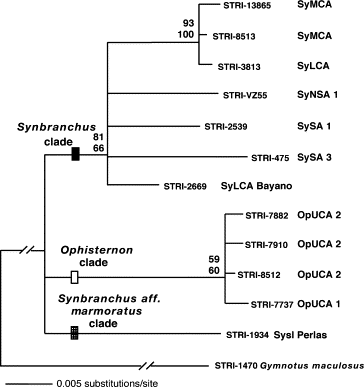Classification
Domain: EukaryaKingdom: Animalia Phylum: Chordata Class: Actinopterygii Order: Synbranchiformes Family: Synbranchidae Genus: Ophisternon Species: Ophisternon candidum (Department of the Environment, 2014)
The blind cave eel was first observed
by Alf Snell in 1959. (Romero & Paulsen, 2001) The domain Eukarya is
a large encompassing classification that covers any organism with
eukaryotic cells. This means that the cells within the blind cave
eel have both nuclei and membrane bound organelles. Kingdom Animalia
is distinguished as multi-cellular heterotrophs. The phylum Chordata
implies a dorsal nerve chord. Members of this phylum also exhibit a
notochord and gill slits near the pharynx. The class actinopterygii
are better known as the ray-finned fishes. This class is far and
away the most successful class of fishes and vertebrates in general:
they make up half of all vertebrates that are extant. This class
covers an extremely broad and variable group of organisms that all
meet the criteria of being a fish(what is criteria of being a
fish?). ( Jonna, 2004) The order synbranchiformes is made up of
organism that can be called(change wording) spiny eels. The defining
characteristics of this order include an elongated body, a lack of
pelvic fins, and the confinement of gill slits to the lower portion
of the body. (Nelson, 1994) Members of the class Synbrachidae are
more commonly known as swamp eels. ( Bray & Thomas, 2011) The
members of this class are distinguishable by their lack of swim
bladders, ribs, and nearly all fins. (Nelson, 1994) The scientific
name Ophisternon candidum can be broken down into its two
constituent terms. Ophisternon comes from the Greek word “ophis”
which means serpent, a reference to the blind cave eels elongated
body shape. The species epithet candidum comes from the Greek
“candidus” which means white in reference to the blind cave eels
unpigmented body. (Bray & Thomas, 2011) Thus Ophisternon candidum
literally means white serpent, which is a fairly accurate
description of the blind cave eel's morphological characteristics..jpg)
Kingdom Animalia
Figure 1. Phylogeny of Kingdom Animalia. Phylogenies such as this
one are based off of evolutionary relatedness. The blind cave eel
belongs to the phylum chordata. This phylum is separated from other
non-sister taxa by undergoing deuterostome development. The
characteristics separating chordata from echinodermata have been
outlined above. This phylogeny only shows the nine major phyla.
Kingdom Animalia actually includes forty phyla.
Family Synbranchidae
Figure 2. Phylogeny of the family Synbranchidae (swamp eels) From
Pedices et al. This phylogeny is based off of molecular sequencing
of the RAG-1 gene. The samples of the gene were obtained from
Ophisternon aenigmateicum from the Ophisternon clade and from
several Synbrachus sps. This phylogeny establishes the strong
division of the very morphologically similar Ophisternon and
Synbrachus genera. These two representatives of the Synbranchidae
are nearly morphologically identical and thus must be separated by
genetic means.
obtained from
Ophisternon aenigmateicum from the Ophisternon clade and from
several Synbrachus sps. This phylogeny establishes the strong
division of the very morphologically similar Ophisternon and
Synbrachus genera. These two representatives of the Synbranchidae
are nearly morphologically identical and thus must be separated by
genetic means.